Incorporating Multiple Audiences into Your Survey
Incorporating Multiple Audiences into Your Survey

Have you ever needed to create multiple audiences under one sampling pool for your survey research? Now you can, with the new Multiple Audience feature in the Pollfish dashboard.
This feature creates a hyper-targeted audience landscape, allowing you to select various demographics, mobile usage and geolocation criteria — for multiple audience groups. Previously, the platform allowed researchers to select these criteria, but for one audience group only.
The Purpose of the Multiple Audience Feature
With this new feature, you will be able to create separate audiences in one survey and achieve any targeting combination you desire.
Essentially, the feature allows you to apply quotas within the quotas and conditions within conditions. You can also use minimum quotas, in which only a percentage of an audience gets assigned a quota (which you select), while the rest does not and will therefore receive random response types.
This will allow you to achieve a hyper-granular approach to targeting your sampling pool, aka, the survey respondent audience.
Laying Out the Components of the Multiples Audience Feature
The feature includes separate audience blocks that can be customized as you so choose. Each block represents an audience group, i.e., Audience 1, Audience 2, etc. There is no limit to the number of audience blocks you can create, so long as they don’t exceed the total amount of survey completes.
The blocks also present a wide variety of audience category selections. As with the previous single-audience capability, this one allows you to create quotas for each type of demographic, geolocation and mobile usage selection, along with a maximum of 3 screening questions. This is known as layered demographics conditions, which are also called interlocking quotas.
Prior to the update, researchers were able to apply separate quotas to each targeting variable (non-interlocking quotas, or overlapping quotas). For example: in a sample pool of 1,000 respondents, the requirements may be: 500 (50%) men and 500 (50%) women, 500 (50%) young people and 500 (50%) older people. In this instance of non-interlocking quotas, you risk a pool of 500 young men and 500 older women.
Interlocking quotas can avoid this, in which a quota is defined by more than one variable. The interlocking percentage involves multiple variables, for example, household income, gender and age.
In reference to the aforesaid example, you can define a target size for each combination of variables. That means you can mandate 250 young men (50% x 50%) 250 young women, 250 older men and 250 older women. This assures that not only will you get respondents of every variable, but that they are collected evenly (if you so choose with your assigned quotas).
Each audience, regardless of how different will have the same language, as they are each part of one survey, i.e., one sampling pool.
The Pollfish platform will calculate the CPI and feasibility of the survey by taking into account all the conditions of each audience.
How to Create Multiple Audiences
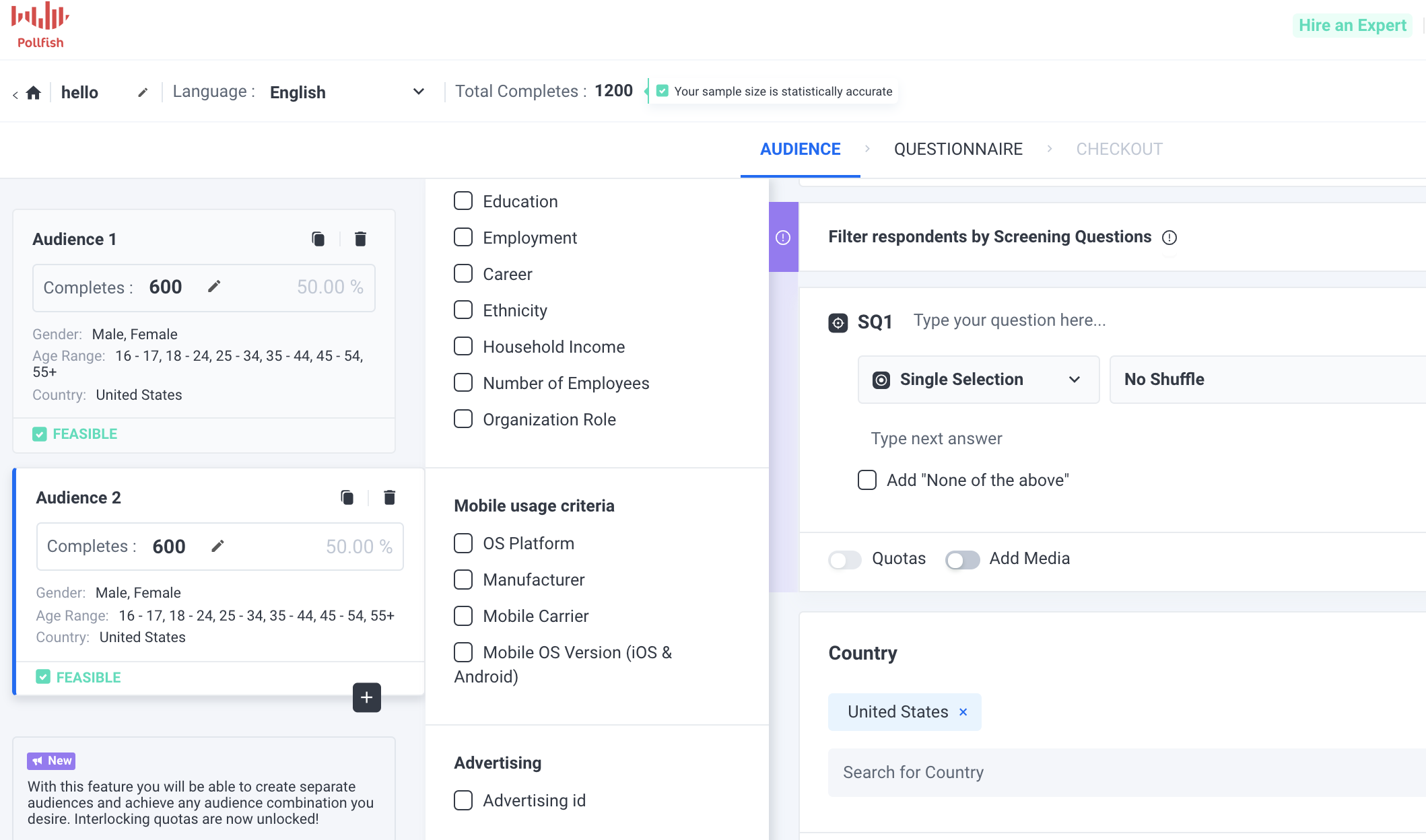
To create multiple audiences and use their various features, follow these steps. Keep in mind that, while they give complete direction in using all the new feature’s functionalities, your survey may go in a different direction. As such, you may not have to follow all the steps enumerated below if you don’t need certain functions and additions.
- Create a new survey.
- You will be taken to the “audience” interface.
- Begin by choosing the number of completes — the maximum number of respondents in the first audience.
- The total completes on the top left will reflect how much completes you have by adding up the completes in each audience block.
- Start with the age and gender criteria. Select the subcategories your survey is targeting. Add quotas to each subcategory (male or female, or within the age ranges).
- Next, move onto the screening questions portion and add three questions that pertain most to your survey (a maximum of 3 per survey, meaning a maximum of 3 no matter how many audiences you add).
- Decide which criteria to use for this particular audience, as you can choose various subcategories under demographics, geolocation, mobile usage and even advertising ID.
- By enabling this criterion, all responses of the survey will be accompanied by the respondent’s advertising ID (in an Excel sheet export).
- Once you decide which criteria to use, apply quotas. You may add more or less completes to Audience 1, just make sure you don’t use up the total completes.
- After setting up your first audience, click on the + icon on the bottom of the Audience 1 block.
- This will open up a new audience group, aka, block.
- Follow steps 2-6 for your next audience selections.
- Follow step 7 should you wish to add more audiences.
- Review the entire audience section. Check the total completes to ensure you’re going to enlist the correct amount or respondents in the platform.
- Also, make sure the audience blocks are all feasible.
- If a block is not feasible, adjust the targeting design of the audience related to a ''not feasible'' estimation to make it feasible. You can expand the targeting, remove quotas or filters.
- You’re all set with Multiple Audiences and the audience section at large; you can now move on to the questionnaire.
This new feature will allow you to hyper-target your survey to befit a wide variety of segments in your target market, or any of your subject of interest.
Survey Research Methods: A Deep Dive
Survey Research Methods: A Deep Dive

Although survey research methods are just one tactic under the enveloping market research field of study, they too are administered in a number of ways.
That is because much like market research, there is no single or universal technique when it comes to survey research. Instead, there are various survey research methods, those that only pertain to the survey aspect of market research.
Survey research methods include different sets of classifications, from types of surveys, to data organization and more. It is key to become familiar with all of them to determine which is most suitable for your market research needs.
This article will navigate all the nuances that pertain to survey research methods.
Surveys for Quantitative vs. Qualitative Research
Market research relies on both primary and secondary research; surveys fall under the former and have several classifications. The first major one conveys the duality within survey research methods: that of quantitative and qualitative research.
Quantitative research surveys:
Quantitative research involves gathering quantitative, or numerical data. Surveys amass this data by asking questions that quantify attitudes, opinions, feelings and behaviors. The point of this kind of survey research method is to form generalizations.
Quantitative research surveys therefore use a larger sample size in order to crunch numbers on different issues and variables. This survey research method is highly dependent on using and creating mathematical and statistical data.
These surveys use this data to identify patterns in a target market, find averages, make predictions and test relationships.
Essentially, this survey research method uses respondents to understand the “what” and “how much” of a studied subject.
Qualitative research surveys:
Qualitative research zeroes in on experiences, ideas and opinions, instead of focusing on statistical or quantitative results. Instead, this survey research method seeks to holistically interpret an issue, occurrence or phenomenon.
As such, qualitative research seeks to perceive an issue in more depth, find the cause of an occurrence, create inferences, find solutions to problems and uncover trends.
This research method is centered around the “what” and even more so, the “why” of a research subject.
Unlike quantitative research, qualitative research uses a smaller sample size for a deeper understanding of causes, motivations and sentiment.
This kind of survey research method uses open-ended and exploratory questions in natural environments, in which respondents freely discuss their opinions to help researchers identify the “why” behind an issue.
Understanding the “why” is then used to make decisions on how to resolve the issue or how to improve on an existing productive situation.
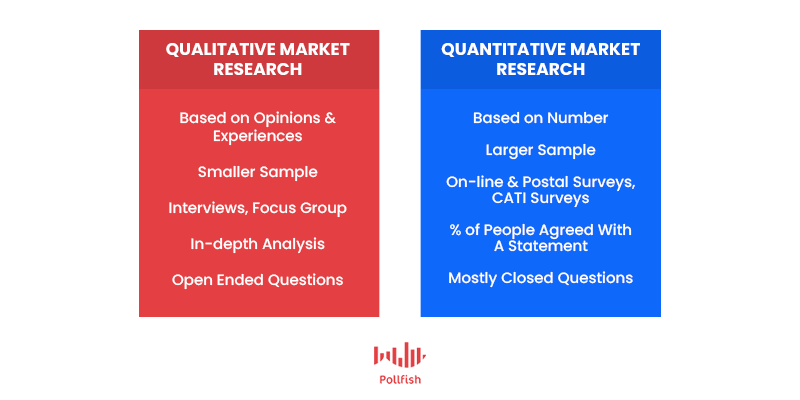
Survey Panels Vs Random Sampling
The second main classification of survey research methods is categorized via the sampling pool. There are two main types of sampling pools, i.e., the type of respondents that take part in a survey.
Market Research Panel:
A market research panel is a pre-recruited group of survey respondents who have agreed to take part in online surveys. This method is most commonly employed by market research panel companies, which require the panelists to share personal information about themselves.
This includes the information you’d find at the screener section of a survey tool such as demographics, but can also include behavioral data. The panel can be used for more than one survey; this way is convenient for market researchers who require long-term survey campaigns such as longitudinal surveys.
Random Sampling Pool:
A random sampling pool is a group of survey respondents who have not been recruited to take part in a survey. Instead, this method involves, as the name suggests, a random group of participants. They take a survey once they reach a publisher’s website or app, which is triggered by an online survey tool. As such, they take a survey due to their being real-time users on a site or app in which the survey has been launched.
Any business can take this automated approach, which does not require seeking out participants manually, as a market research panel would. Although the pool of respondents has been gathered randomly, the qualifying participants are not random.
This is because the survey software used to launch this survey includes screening questions and demographic requirements that respondents must meet to take the survey. As such, researchers still get the exact kind of participants they seek to survey. This survey research method includes probability and non-probability sampling.
Survey Research Methods Based on Campaign Type & Macro Applications
Survey research methods can be further divided based on the type of macro application (or discipline) you need the data for. They can also be categorized into different campaign types, which can fall under the macro applications, or exist as their own application.
You should understand these purposes before you choose the proper survey type for your research needs. Here are the major campaigns and applications to base your survey method on:
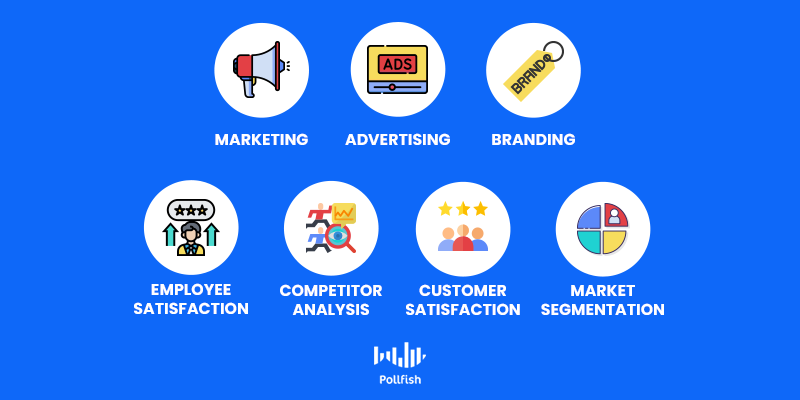
- Marketing: A broad term that includes a wide variety of processes to raise awareness and demand in your company, promote it and understand your target market.
- Advertising: One of the key practices in marketing, advertising refers to communication using overtly sponsored messages to promote or sell a product or service.
- Branding: The development of a brand’s reputation and image, along with increasing the recognition of your company.
- Market Segmentation: Facilitates targeting those most likely to be satisfied customers of your company or content. It involves splitting your target market up into smaller groups of people with similar characteristics.
- Competitor Analysis: It is the process of identifying and assessing your competitors based on their strategies to unearth their strengths and weaknesses relative to your brand.
- Employee Satisfaction: The degree to which employees are content and fulfilled with their jobs, including their schedule, work environment and banter with fellow employees.
- Customer Satisfaction: The measurement of how happy customers are with a company's products, services, experiences and interactions.
Types of Surveys
Finally, we arrive at the types of surveys, the most granular aspect of survey market research methods, that is, unless you delve further by looking into survey questions.
These surveys are classified as belonging to either quantitative or qualitative methods, along with their best application type. As for the latter classification, you ought to know that these surveys are not necessarily limited to these applications.
Rather, they are most apt for the named applications and campaigns, but due to the versatile nature of surveys, the following can be used in other applications, including those not mentioned in this article.
- Cross-sectional surveys: Gather data to make inferences about a population at some point in time.
- Used to provide snapshots of the populations they survey.
- Drawn from a few specific variables to narrow down a unique and smaller population.
- Method: Quantitative surveys
- Best used for: advertising, market segmentation, employee satisfaction, customer satisfaction, branding
- Longitudinal Surveys: Study variables over longer periods of time. (Weeks to decades)
- Require more dedication from respondents and researchers, including time and money. In this regard, a larger pool of participants is used and studied for much longer.
- Like cross-sectional surveys, these are also observational and study the exact sample pool for the length of the study.
- Method: Primarily qualitative, but can be quantitative
- Best used for: marketing, competitor analysis, market segmentation
- Retrospective Surveys: Merge aspects of both cross-sectional and longitudinal survey methods.
- Observe changes that occur over a longer period of time, but are facilitated just once.
- Thus, responders discuss occurrences, attitudes and feelings from the past.
- Method: Qualitative and quantitative surveys
- Best used for: Marketing, branding, competitor analysis
Going Beyond Survey Research Methods
Understanding the various survey research methods are crucial to forming the most fitting market research campaign for your brand. However, it doesn’t end here. With innovations in the market research field, other survey methods and sub-methods are going to emerge.
Moreover, after you’ve found the best survey research method(s) for your company, you’ll need to conduct the proper survey data analysis.
As such, you’ll need to analyze your surveys, and this can be done in a number of formats. Some are going to be more visual than others.
After all, conducting surveys is one thing, but understanding the surveys is the centerpiece of any research campaign.
Frequently asked questions
What is a quantitative research survey?
A quantitative research survey is one in which all responses can be assigned a numerical value so that results can be easily analyzed. They are used to quantify thoughts, feelings, and behaviors in order to make generalizations about the target market.
What is a qualitative research survey?
A qualitative research survey is used to gain a deeper understanding of the ideas, opinions, or experiences of a group of people. This type of survey uses open-ended questions that allow respondents to discuss their opinions freely.
What is a market research panel?
A market research panel is a group of individuals who have been selected to participate in a series of surveys over a specific period of time.
What is a random sampling pool?
A random sampling pool is a group of individuals who have been selected at random to participate in a survey. In an online survey tool, a sample pool is derived via automation.
What is a longitudinal survey?
A longitudinal survey is one that studies a group of individuals over a period of time, which can range from weeks to decades.
The Complete Guide to Quantitative Market Research
The Complete Guide to Quantitative Market Research

Quantitative research is a chief category in the research sphere, along with qualitative research. An encompassing aspect of market research, it can include both primary and secondary methods of extracting data.
Although used interchangeably with qualitative research, quantitative research is a distinct process that should not be confused with its counterpart. In fact, it is the opposite of qualitative research.
Let’s navigate through the waters of quantitative research in this complete guide.
What Defines & Makes Up Quantitative Research?
As its name suggests, quantitative research is the process of aggregating quantitative, or numerical data for research purposes. This data is used for a number of applications. These include:
- Quantifying opinions, behaviors, attitudes and problems
- Making generalizations
- Forming predictions
- Discovering patterns
- Determining averages
- Testing relationships
Quantitative research generally relies on a larger sample size in order to quantify any issue or variable. In order to achieve this, this research method involves using mathematical and statistical means.
This type of research answers the “what” and the “how much” of a subject within a research endeavor. As it forms generalizations, this type of method involves surveying a larger population, using measurable data and processing all the data first and then analyzing it from a statistical standpoint.
The Four Main Types of Quantitative Research
There are four main ways to perform quantitative research. Aside from their methodology, these sub-categories also seek different types of answers and conclusions.
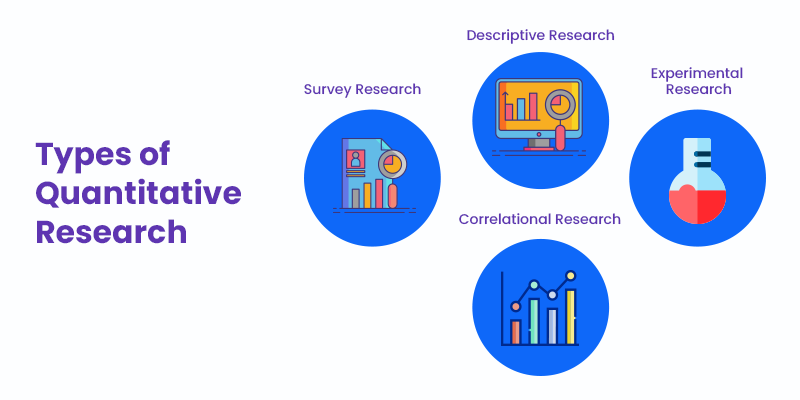
1. Descriptive Research
This is used to determine the state of variables. It describes the situation and environment surrounding a variable or topic. As such, it is used for arranging comparisons, outlining sample characteristics, overlooking emerging trends and confirming existing phenomena.
The data is collected by way of observation. Descriptive Research is used to form a hypothesis, but only after having aggregated all the necessary data.
2. Correlational Research
This research method is used to examine the relationships between different subjects and variables. Analyzing relationships is necessary to either test a hypothesis or a prediction. Because this research focuses on relationships between fixed variables, other outlying variables are not part of the investigation.
Correlational research is in direct opposition to experimental research, as none of the studied variables are manipulated. Correlations can be either positive or negative, with different degrees of the relationship’s strength.
3. Experimental Research
This method is used for finding whether there is a cause and effect relationship among variables. This kind of research relies on the scientific method. Unlike correlational research, experimental research involves manipulating variables.
Researchers would manipulate a variable to uncover its effect on another one. This method is frequently referred to as true experimentation, as no experimental undertaking leaves all variables unchanged; at least one must be influenced in some way.
This includes manipulating, randomizing or reverting back a variable. The variables are then measured, calculated and compared.
4. Survey Research
The final research method is crucial to understanding behavior. In market research, it is often used to acclimate a brand with its target market’s desires, needs, points of contention and behaviors.
Surveys allow researchers to ask pointed questions to either discover their target audience or get a granular sense of their opinions. As such, they can be conducted within one group or many, for the sake of comparison.
Instead of turning to survey panels, which are likely to have skewed or biased results, researchers should use a random sample of people. A non-panel-based survey will garner more respondents that aren’t motivated by professional compensation.
Surveys can be administered by mail, in-person, on the phone, or digitally using various market research tools. Digital methods offer even more options, including online surveys, third-party platforms, email, and in-app surveys.
Examples of Questions for Quantitative Research
Survey research has a far larger scope of questions than do the other three types, as researchers can ask practically anything to conduct their studies. However, there are some best practices in survey questionnaires, such as focusing on your industry, your product and the desires of customers.
Learn more about asking insightful market research questions. Here are a few examples of quantitative research questions in the three other categories.
- Is working from home the best option to improve productivity for employees with long commutes?Variable: Working from home and in-office
Demographic: Employees with long commutes
Quantitative Research Type: Experimental - How has the coronavirus changed employment for white-collar workers?
Variable: Employment types and statuses
Demographic: White-collar workers
Quantitative Research Type: Experimental - How often do working people travel for a holiday?
Variable: Amount of times respondents travel during a holiday
Demographic: working people
Quantitative Research Type: Descriptive - How much would you pay for a subscription to an entertainment magazine?
Variable: payments for a magazine subscription
Demographic: women aged 14-44, those interested in celebrities
Quantitative Research Type: Descriptive - What is the difference in smartphone usage between Millennials and senior citizens?
Variable: Time spent on using a smartphone
Demographic: Millennials and seniors
Quantitative Research Type: Correlational - Does the leadership style of car shop owners predict the job satisfaction of car salespeople?
Variable: Leadership style and job satisfaction
Demographic: Car shop employers and salespeople
Quantitative Research Type: Correlational
When to Use Quantitative Research and How to Analyze It
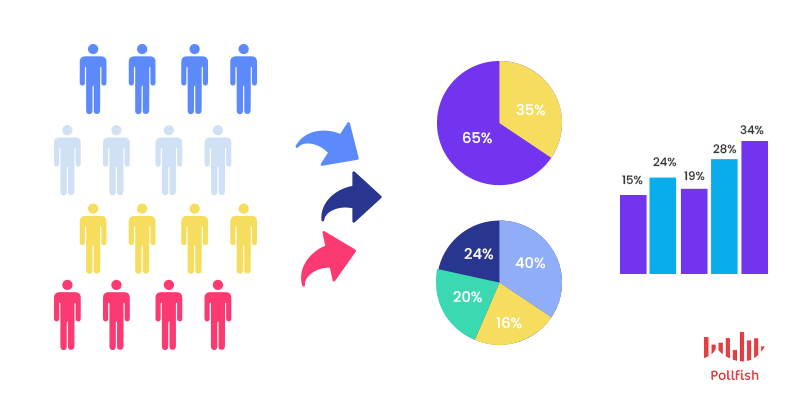
The quantitative research method has specific use cases. You ought to consider which is best for your particular business, which includes your strategy, your marketing and other facets.
The core of quantitative research is to quantify a phenomenon (a problem, an inadequacy, and a slew of other occurrences) and understand its prevalence. Researchers do this by observing large portions of a population.
You should use this form of research whenever you need to be presented with the state of things at a higher level, or from a bird’s eye view. This Is because this type of research can identify links between various factors, look for correlations and discover cause and effect relationships.
Researchers can then use the results of their findings to form predictions. This is useful in market research when launching a new product, brainstorming product ideas or innovations or growing a customer base.
To analyze this research, it should first be made quantifiable and objective. Researchers should pin down the scales and units of measurements in their various studies. Then, they should organize them into easily interpretable formats.
For example, once you gather the numerical data, you can enter it into a spreadsheet. Thereafter, you can organize it by desegregating it into graphs, charts and tables. Finally, you should draw data-based conclusions from your study. You can also do further sleuthing via advanced analytics, which is made easier using a survey software for market research.
The Benefits and Drawbacks of Quantitative Research
Quantitative research has a bevy of benefits; it also has some hindrances. You should peruse both the positive and negative qualities of this research type before setting out on any major research project. The following may help you choose one form of research over the other, or use aspects of both.
Benefits
- Larger sample pools: the larger the group of respondents, the more accurate are the results.
- Highly structured: Surveys, questionnaires, and other tools for recording numerical data
- Focused: The design of the study is determined before it begins
- Theory-based: Research tests a theory to provide support/proof
- Designed to Be Analyzed: Numbers/statistics exist as tables, charts, figures and other non-textual forms for easy analysis.
- Objective: Steering clear of bias as the research is separated from the data & only objective responses are sought.
- Direct comparisons of results: The study can be set in different cultural environments, times or different groups of participants with a statistical comparison of results.
Drawbacks
- Focuses solely on numbers: This can be limiting as researchers may overlook other data and larger themes.
- Superficial Representations: It cannot adequately describe complex concepts (ex: feelings, opinions) it only shows the numbers behind them.
- Several factors can invalidate results: A hypothesis and a model for collecting/ analyzing data.is required; any mistake can lead to bias and inaccurate illustrations.
- Erred Structure: If any data is missing or if measurements are not clear, biases easily take precedence.
The Final Word on Quantitative Research
Market research is far too encompassing to fully complete, especially in a limited amount of time. To tackle market research, begin with a research method. Quantitative research is often a good starting point to get survey responses, as it shows you the existence of a problem by way of quantifying it.
Aside from confirming the existence, it can help confirm a hypothesis, find correlations and prove cause and effect relationships. A hard set of data can also help you make educated predictions.
While the three types of quantitative research methods are useful, they do have several disadvantages. The fourth one, ie, survey research helps fill in the gaps and inadequacies of numerical limitations. Interestingly enough, they too can be a source of hard data and numbers.
Either way, market research is sure to benefit from incorporating surveys as part of the processes.
Frequently asked questions
What is quantitative market research?
Quantitative market research utilizes the techniques of quantitative research in order to better understand the target market. In quantitative research, the information gathered from surveys and questionnaires is converted into numerical values so it can be easily analyzed.
What types of questions do quantitative research answer?
Quantitative research seeks to define “what” and “how much.” It is used for identifying patterns, making predictions, establishing averages, and quantifying opinions, attitudes or behaviors.
What are the four main types of quantitative research?
The four main types of quantitative research are survey research, correlational research, descriptive research, and experimental research.
What type of surveys are used for quantitative research?
Quantitative surveys are best suited for quantitative research. In this type of survey, there are no open-ended questions, and all responses can be assigned a numerical value. In most cases, a quantitative survey is distributed to a large and random sample of individuals.
Why are large sample sizes important when conducting quantitative research?
A small sample size can lead to inaccurate results. The larger the sample size (i.e. the group of individuals who receive the survey), the more likely it is that the results will be statistically significant and accurate.
Amassing Community Feedback with the Community Survey
Amassing Community Feedback with the Community Survey
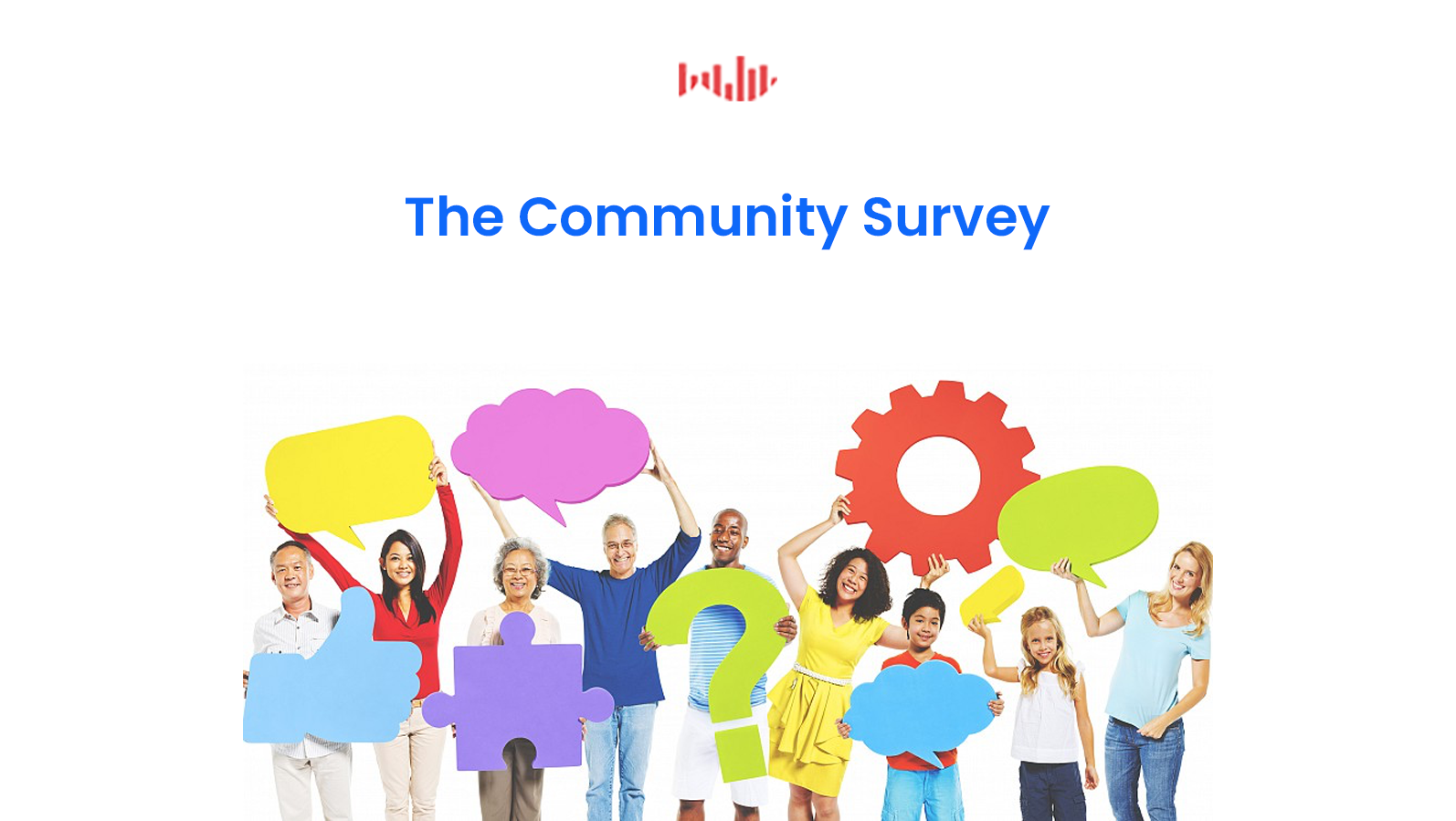
The community survey. Although less known than the main types of market research surveys, this type of survey offers invaluable insights into your target market through a local lens.
Consequently, it is a location-based survey, meaning that it elicits responses from the local residents of a community, or a small geographic region.
A community survey does not represent a community in the more abstract or holistic way, in which it can denote a group of like-minded individuals. The term that grasps this idea is that of the target market, which is what most survey research is based on, at least to some degree.
On the contrary, a community survey is gripped to a geographical site. This article explains what this survey is and why it is crucial for certain types of marketers and business owners.
Identifying the Community Survey
Not to be confused with the American Community Survey program, which is sometimes simply referred to as a Community Survey, the general meaning behind a community survey is a survey that studies the behaviors, preferences, attitudes and opinions of people who live in a particular area — the community in question.
Since this kind of survey is anchored in a location, participants must be screened on this very demographic. That is to say that your survey should include screening questions and quotas on the demographic of location.
Since it is designed to measure a community, you should set your geographical preferences to the local level in your survey, instead of a macro level, such as state or territory.
That way, you can capture the feedback of a local community, instead of a wider area containing multiple zip codes.
The Importance of Collecting Community Feedback

This type of survey reveals the problems and needs of a community which your business can help address, thereby increasing (or establishing) a foothold in the area for your business. As such, conducting this kind of survey can help grow your revenue and business at large.
Collecting community feedback is especially necessary if you operate a brick-and-mortar business. This is because your business exists in a geographical context (at least in your physical store), and should thus take into consideration all the associated factors of that context.
After all, you won’t be able to properly market your local business to locals, if you know nothing about them.
Gathering community feedback is also crucial if you are considering to psychically branch out your business into a particular community. You may have come upon a particular neighborhood while conducting real estate market research and mulled over if it’s worth opening a brick and mortar there.
In this scenario, collecting community feedback also comes into play, as it will lay any of your doubts and curiosities to rest. That is, of course, if you conduct community feedback.
The most auspicious way to collect this information is by conducting a community survey.
The Benefits of Implementing a Community Survey
Whether you’re set to conduct a community research campaign for marketing, advertising or for the objectives covered in the previous section, a survey designated for this research is a must.
As aforesaid, a community survey helps you uncover the attitudes, needs and opinions of a particular community.
It is the chief primary research method for garnering community feedback, unless of course, you’re going to conduct interviews, which is a far more costly and time-consuming task.
Here are some more critical ways your business can benefit from a community survey:
- Allows you to understand the major needs of your local community’s target market
- Allows you to tweak your product or service in a way that’s best suited for the community
- Gives you the chance to fill any major gaps your niche has in the community you study
- Informs you on how to market and advertise your product to the community
- Enlightens on the ethnic makeup of the community, including local languages, cultures and even lifestyles (think surrounding institutions)
How to Create a Community Survey
Now that we’ve covered community research, feedback and the advantages of the community survey, let’s dive into creating one. When conducted the correct way, a community survey is no feat; it is simply an asset to your market research needs.
We’ve mapped out the 7 steps of creating an effective community survey.
1. Find the main purpose(s) of your survey.
Figure out the goals you intend on pursuing with your survey. To do so, ask yourself the following:
- What are some of the primary insights you want to glean from this survey?
- How will surveying this particular neighborhood help you help you find these?
- How can your business better assist the residents of a neighborhood?
- How do residents feel about the community and what would they change about it?
- How can your business provide a better experience for the entire community?
2. Draft a set of questions aimed at fulfilling the purpose of the survey.
Once you have a purpose or more for your community survey, tailor your questions to achieve that purpose.
Since it is a community survey, ask several questions that are most relevant to the community, whether it pertains to its physical setting, the language respondents prefer to speak, or the issues they face, especially as they relate to buying from your business.
Here are a few question examples:
- What is the best part about shopping in this area?
- What is your favorite type of [product you offer]? Would you go out to buy it?
When you’ve come up with a set of questions, consider adding advanced skip logic. This mechanism involves using a custom question path for respondents who give particular answers.
For example, if a respondent answers that they don’t know about a particular store in the area, the survey shouldn’t lead them to a question about the store. Instead, it should route them to relevant questions only, which is how skip logic maneuvers.
3. Put your survey on pilot mode.
It may be tempting to hit the ground running once you’ve come up with a set of key questions, especially if you’ve added skip logic to them.
However, as with any successful campaign, you should ascertain that your survey is ready to be sent out to the masses, even if it’s a rather small community.
To do so, test your survey by running it by your team members. Let them take a stab at it to discover what they think and whether there are any typos, irrelevant questions or other errors.
Then, once they give you the green light to launch the survey, send it to a small sampling pool. For example, let’s say there are 5,000 members in your community. Send it to 50 to see how your survey fares.
For example, perhaps respondents left negative feedback in the final question about the survey itself. This can help you revamp the survey for a better experience.
Or, perhaps the respondents gave nonsensical answers to the open-ended questions. Either way, you should test the survey out before you do any large-scale launches.
4. Deploy Your Survey to Your Community
After running your survey on pilot mode, distribute it to members of your community. Do so via Google Forms or through a survey platform.
This survey platform should help you add all the questions you need, apply advanced skip logic, use screening questions, add quotas, and most importantly, deploy the survey to your community of study only.
5. Streamline the Participation
To quicken the study, consider using incentives. If you use a survey platform, ensure that you can communicate this incentive to your respondents in the website or app your survey is distributed to.
Or, make sure that the participants can at least be informed of an incentive when they click on/open the survey in the publisher’s site/app.
The incentive can be a small discount on your product/ service, or entry in a giveaway. Feel free to get creative.
You can also streamline the survey completion time by opting for a survey platform that allows you to implement quotas on the demographics you qualify to take the survey. To stay ahead on the timing, it is apt to use a tool that forecasts the survey’s total completion time.
6. Conduct a survey analysis
When you’ve reached the total responses you preset the survey tool to receive, it’s time to do a survey analysis. To analyze your freshly accumulated data, organize it in the following ways:
- View your data in different formats for a high-level understanding, export it as an Excel sheet, or view it as charts, graphs and other visualizations that your survey platform permits.
- Apply market segmentation by breaking up answers’ based on respondents’ age, gender, income, etc., and studying their answers on a segmented basis.
- Organize market segmented data into spreadsheets and other data formats.
- Compare responses with cross-tabs to uncover relationships between variables
- Read your open-ended responses, categorize them if you find similar answers.
6. Summarize Your Findings and Prioritize Next Moves
After you’ve analyzed the results, you should summarize any patterns, relationships and other key findings in a document.
Afterward, share the document with your team members, particularly data analysts, market researchers and marketers. You should come up with a plan of action based on the summary.
Begin by prioritizing the most pressing needs of the community, especially if they appear doable. Then, plan out other outstanding needs and set timeframes, so that you’re running operations smoothly.
Keep in mind that some issues may seem scathing but only have affected a small fraction of respondents. Thus, they don’t pertain to the entire community. To that end, you may want to consider whether addressing those issues is worth doing at all.
Seizing Community Feedback to a Maximum
A community survey not only helps detect the issues and concerns a community may harbor. This type of survey informs you on how to best market to the community, including how to innovate your service and experience for them.
But remember, this survey is only one primary research method used in collecting community feedback and research. You should therefore conduct other methods of primary research, along with secondary research on a community before you begin setting up your survey.
After all, conducting secondary research may reveal a neighborhood you previously didn’t know about, one that you can possibly venture into in your next brick-and-mortar store.
Frequently asked questions
What is a community survey?
A community survey is a location-based survey that seeks to better understand the feelings, attitudes, or behaviors of the residents of a small geographical community, such as a neighborhood or zip code.
Who is the intended audience of a community survey?
A community survey is conducted to elicit responses from a small geographical location. The target audience should be a narrow region, such as a single zip code or neighborhood, rather than a larger area, such as a state.
What types of businesses can benefit from a community survey?
Brick and mortar businesses are most likely to benefit from a community survey since they tend to serve nearby communities. Grocery stores, clothing shops, health and beauty stores, and real estate agents are all examples of businesses that can benefit from a community survey.
How can a business benefit from a community survey?
Businesses can use a community survey to better understand the needs of the local market and thereby adapt the product/service to best serve that market. It can also be used to identify a niche for your product in the local community.
How is a community survey used to support marketing and advertising campaigns?
A community survey can help inform marketing and advertising campaigns by shedding light on the demographic and cultural makeup of the local community, including information about language, lifestyle, interests and needs.
Diving into the Employee Satisfaction Survey
Diving into the Employee Satisfaction Survey
 Whether you operate a small, mid-sized or enterprise business, a high level of employee satisfaction is a must, thus you’ll need to employ (pun intended) an employee satisfaction survey.
Whether you operate a small, mid-sized or enterprise business, a high level of employee satisfaction is a must, thus you’ll need to employ (pun intended) an employee satisfaction survey.
First, you should mull over the notion of employee satisfaction: the term itself doesn’t denote contentment among employees. Rather, it signifies the concept of whether employees are content with their needs and wishes in their job.
As such, it is treated as something to measure, as a healthy amount of employee satisfaction leads to better job performance and productivity. Conversely, poor satisfaction leads to low morale and high burnout, which inevitably lead to higher turnover rates and ultimately affecting a business’s bottom line.
But as a business, you can disentangle yourself from this predicament — or avoid it from occurring to begin with — with the employee satisfaction survey.
What is an Employee Satisfaction Survey?
This kind of survey gauges the level of satisfaction your employees have with their jobs: this includes culture, work environment, visibility and all employee relations. It is a tool best executed by the human resources department, as this team works chiefly to fulfill employee needs.
However, the intelligence derived from this kind of survey should be shared with upper management, so that higher-ups can see how employees are faring, make decisions on how to improve their satisfaction and devise plans with HR on how to better oversee the company.
Your business should periodically issue these surveys to your employees, as even the happiest of them can have a change of mood. Perhaps something in the company changed for the worse? Or perhaps, the new project management system is difficult to adapt to.
Whatever the case, your company will benefit from monitoring your employees’ satisfaction.
Why Does this Survey Matter to Your Business?
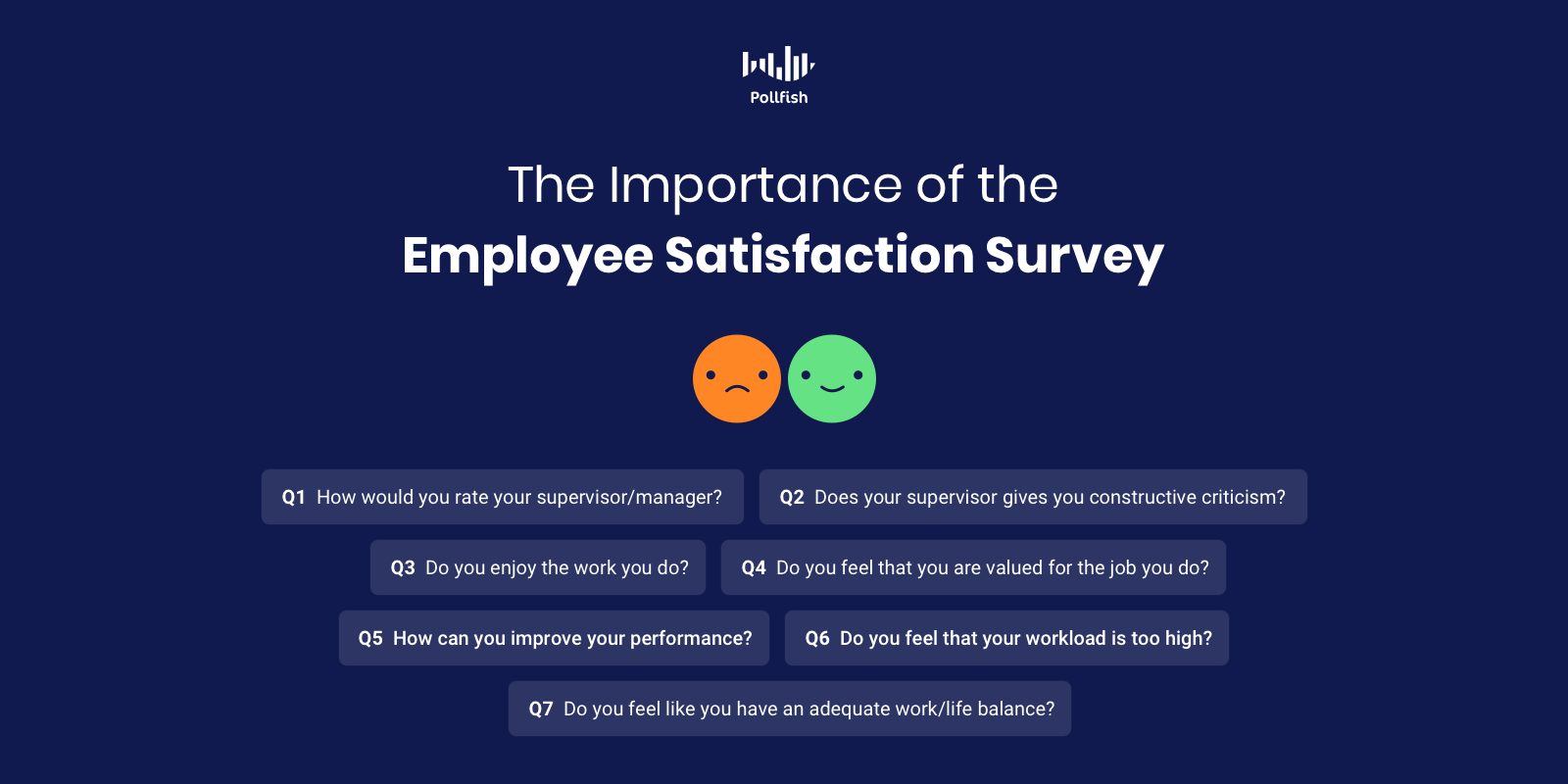
If the above explanation wasn’t reason enough to employ employee satisfaction surveys regularly, the following will. Your HR team cannot read minds, and neither can you. When your employees hit a sour note in any matter pertaining to work, it is best to correct it.
But you won’t be able to unless you know precisely what troubles your employees when it comes to their jobs.
Here are several reasons as to why you should implement these surveys, particularly in regards to unhappy employees.
- Employees’ discontent won’t be remedied if it’s not addressed and if no action is taken against it.
- If unhappy employees don’t like their jobs, they won’t bother to work as diligently as they should; they’ll start slacking and their performance will worsen.
- Discontented workers may get to the point of no return; they may decide to leave the organization. Others may follow suit, leading to high turnover.
- Unhappy colleagues can release their low spirits onto other employees and even customers.
- Dissatisfied workers may lower company morale and culture.
- Unhappy employees will feel like they get to voice their concerns with a satisfaction survey.
- The prospect of fulfillment and improving mental health may seem like a reality to unsatisfied employees when employers set up these surveys.
Questions to Ask in Your Questionnaire

An employment satisfaction survey often deals with many topics, as such, you can create multiple such surveys, or incorporate various topics into one survey. Here are a few types of employee satisfaction question types and question examples.
Questions on relationships with the supervisors and managers
- How would you rate your supervisor/manager?
- Does your supervisor give you constructive criticism?
- Does your supervisor provide your tasks in a timely and comprehensible manner?
- Do you feel that your supervisor understands your concerns?
- Do you feel like your supervisor appreciates your work?
Questions on job enjoyment and comfort
- Do you enjoy the work you do?
- Do you feel that you are valued for the job you do?
- Do you feel that you can pursue job growth in this company?
- Do you believe you’ve gotten sufficient training to solve customer issues?
- Do you feel that your job helps make a difference in the company, the niche, our customers, or the world at large?
Questions on self-evaluation
- Do you complete all your tasks before they are due?
- Do you feel that your workload is too high and that you may require some help?
- How can you improve your performance without inducing any stress?
- How can you improve your performance to help contribute to the company’s success?
- How can you improve your relationship with other colleagues?
Questions on company pipeline and goals
- Do the overall goals of the company make sense for this quarter?
- Do you have an understanding of your requirements and how they fit into the bigger picture of the company?
- Do the objectives for your team seem realistic and attainable?
- Are your own objectives clear and do they seem realistic?
- Do you have any worries about the direction the company is going in terms of goals or your responsibilities?
Questions on work/life balance
- Do you feel like you have an adequate work/life balance?
- If not, what can the company do to adapt to a better work/life balance?
- Do you think your managers take your personal family time into consideration?
- Do you feel stressed out due to long hours or hard to meet objectives?
- Do you feel that your coworkers respect your time off?
Using Employee Satisfaction Surveys to their Fullest Potential
Aside from the question types and topics above, there are many other topics that factor into employee satisfaction. You should consider all relevant topics, as this type of survey doesn’t merely reveal how your employees feel.
The value of these types of surveys is their ability to reveal your company’s own shortcomings and shortsightedness, along with ideas on how to improve managerial relationships and culture. Moreover, they can divulge how to achieve objections, set more reasonable expectations and offer better visibility.
This is to say that these surveys can give indispensable advice on how to run your business. As such, a robust survey platform is key.
Frequently asked questions
What is an employee satisfaction survey?
An employee satisfaction survey is a type of survey that is distributed to current employees of a company to understand how satisfied employees are with various aspects of their job.
Why is employee satisfaction important to a business?
Satisfied employees tend to perform better and have higher levels of productivity, which can in turn lead to increased profits and lower turnover for the company.
How can understanding employee satisfaction help a company?
When a company understands their employees’ pain points, they can make plans to address the issues. Employees who feel that their opinions are heard are more likely to be engaged in the company and perform better in their role.
Who should conduct an employee satisfaction survey?
Ideally, an employee satisfaction survey will be deployed by a company’s HR team, but the results should be shared with upper management and potentially with the company as a whole.
What aspects should an employee satisfaction survey cover?
An employee satisfaction survey can be used to understand how employees feel about a variety of topics, including overall job enjoyment, relationship with the management team, workload and performance, company goals and objectives and work-life balance.
How to Analyze Survey Data Like a Pro
How to Analyze Survey Data Like a Pro
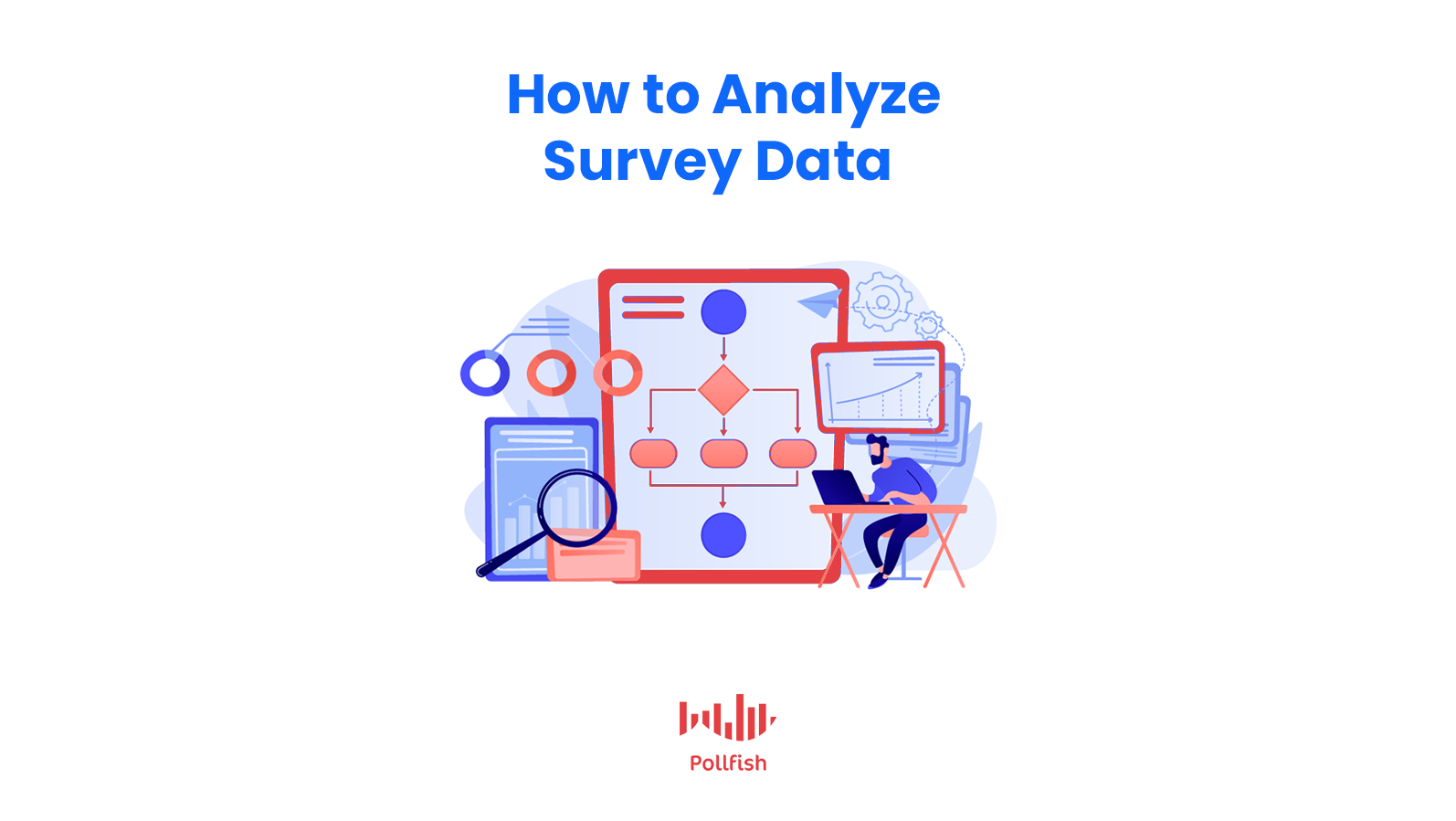
Survey data analysis may feel like a daunting task if you have not conducted many surveys, but the process is easier than you might think. The first few attempts at analyzing your data may feel clunky and cumbersome, but in time you will become adept at viewing and processing survey data.
Whether it is your first or 20th time conducting a survey, knowing how to analyze survey data is crucial to extracting maximum value from your survey results. This guide will walk you through four of the most common types of surveys and provide you with an approach for analyzing data for each type.
Analyzing Survey Data - An Overview
Survey data analysis refers to the process of organizing and examining survey data so you can draw conclusions. The process can be short or long, rudimentary or precise - it all depends on the purpose of the survey, type of data analyzed, consequences of the results, and the skill of the person analyzing the data.
Survey data analysis follows this general process:
- Review the purpose of your survey and the most important questions. Before diving into the data, make sure your analysis stays focused on the survey’s purpose and answers your top questions.
- Review, filter, and cross-tabulate. Sift through the results and think about the best way to organize the data to draw conclusions. Export your data in crosstabs to gain deeper insights.
- Interrogate the data. In this step, you are looking for irregularities that may skew your interpretation of the data. You should consider the statistical significance of your results and identify any areas where sampling bias may lead to inaccurate interpretation.
- Draw conclusions. Once you have gained a deeper understanding of the data, you can draw conclusions and utilize your findings to improve your business.
We have provided just a brief overview of how data analysis is performed before we jump into the specifics on data analysis for various survey types. If you want to learn more, we encourage you to read about how survey data analysis can help grow your business.
Customer Satisfaction Survey
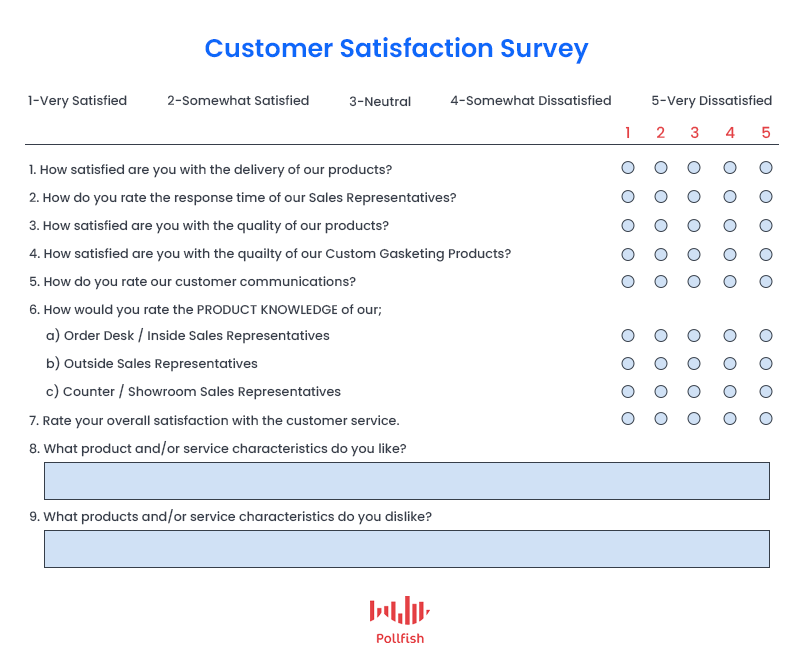
Customer satisfaction surveys provide invaluable insight into your business and help you identify changes to improve the customer experience. When it comes to analyzing the data from a customer satisfaction survey, be prepared to carefully examine both quantitative and qualitative responses.
- After segmenting and organizing your data into appropriate reports, such as crosstabs, the quantitative data from your survey will provide a rich view into the types of customers who were satisfied (or dissatisfied) with their experience.
- Once you have a broad view of the types of customers who either enjoyed or struggled through their experience with your company, qualitative data can give you clues into how to improve the experience to improve satisfaction levels.
- Review open-ended questions of the customers who reported a high satisfaction level. Look for specific examples of what they enjoyed. For example, respondents may mention an easy checkout experience or the helpfulness of your customer service agents.
- Customers who were not happy with the experience are likely to provide even deeper insights. Carefully review their statements and consider what changes you need to make to address these pain points.
Market Research Survey
A market research survey can help you apply educated decisions on how to cater to your target market. For example, your research may help you understand the competitive landscape of a survey platform, but it may not give enough detail into a specific feature you want to develop.
A market research survey could provide more detail, especially when paired with secondary research sources.
- Conduct secondary research, which involves reviewing published data such as consumer research reports, white papers, government statistics, etc.
- Identify where you need additional or more specific information to answer any curiosities you may have about your target market.
- Conduct primary research, which involves gathering self-conducted data, i.e., the data that has not already been obtained and made available.
- Plan your market research survey, deploy, and gather results.
- Analyze your results and draw conclusions. By combining data gathered in your survey with other aspects of your market research, you can leverage the survey data to make more confident decisions.
A survey alone will not suffice when it comes to market research, but when paired with secondary research and other forms of primary research, the data gathered in a survey can be illuminating.
Event Evaluation Survey
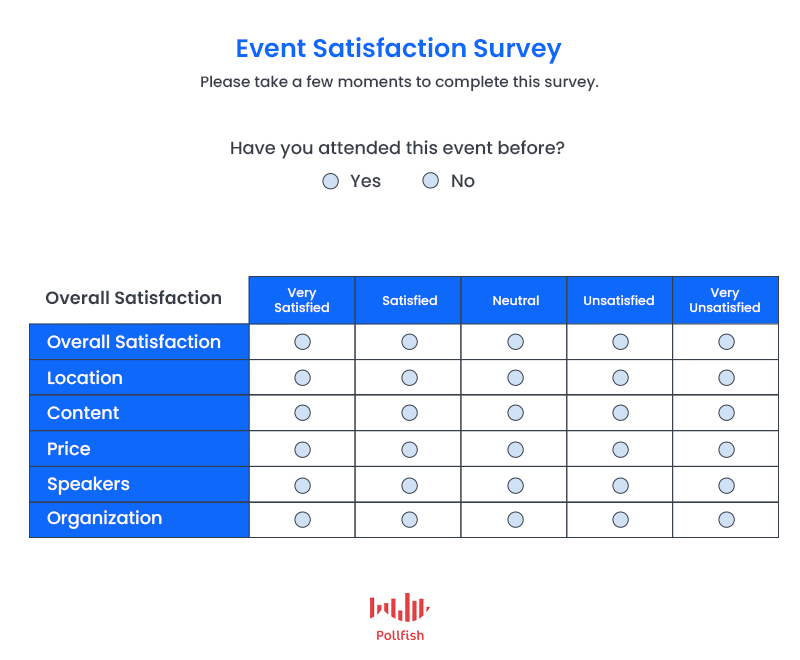
With the time and money dedicated to hosting an event, surveys are important tools for determining the success of the event, whether it was worth the investment and how to improve future events. If you host monthly or annual events, an event evaluation survey is absolutely critical for your success!
- When it comes to analyzing your survey data, again you will need to pay attention to both quantitative and qualitative responses.
- Quantitative data can give you a broad overview of the success of your event. Answers to the following types of questions can help you quickly understand the value of your event:
- Will you attend this event again?
- How likely are you to recommend this event to a friend?
- Was the length of the event too long or too short?
- Were the supplemental resources provided helpful?
- Once you have sorted your data based on response and/or demographics, you can review the qualitative data in the form of responses to your open-ended questions. These personalized responses can help you understand what changes need to be made in order to improve satisfaction with the event.
- If you will have more events in the future, the initial responses can provide you with a benchmark for future events. By deploying surveys after each event, you will be able to see how your changes influence overall satisfaction with the event.
Brand Awareness Survey
Brand awareness surveys are conducted to help a business understand how familiar the target audience is with their brand. Brand awareness has traditionally been very difficult to measure, but if you plan carefully, it will be easier to analyze your survey data.
- First, be sure that you have selected the right audience for your survey via the demographics and screener sections. You need to be specific about your target audience.
- Decide whether you want to do a random sampling to see how many people can recall your brand or whether you want to study brand awareness of existing customers.
- When reviewing the data, carefully examine the characteristics of each segment. This will help you understand the demographics of the people who know the most or the least about your brand. You may discover, for instance, that only those aged 40+ demonstrate brand awareness.
- Understanding the demographics of those who are and are not familiar with your brand can help guide your upcoming marketing decisions. You can decide if you want to strengthen marketing within a segment or try different marketing channels to expand your reach.
Better Analysis Starts with Better Planning
While data analysis is the last step in the survey process, you can make the experience more valuable by considering data analysis during the planning phase. Consider the type of survey you will conduct and think how different data sets will make it easier or more difficult to interpret results.
Data analysis is more fruitful when you have selected the appropriate target audience and have an adequate response rate for your survey. All of this is made easier when you use a professional survey platform to plan, deploy, and analyze the results of your survey.
Frequently asked questions
What is survey data analysis?
Survey data analysis the process of reviewing the data that was gathered during a survey and analyzing it in order to draw actionable conclusions.
What is a crosstab?
A crosstab, or crosstabulation, is a special type of table used in survey data analysis that shows the relationship between two or more variables.
What is statistical significance?
Statistical significance is a term that describes how likely or unlikely it is that a relationship between two or more variables is due to random chance.
When can sampling bias occur?
Sampling bias occurs when certain members of the sampled population are more likely to be selected than others, thus skewing the results. Sampling bias is more likely to happen when respondents are not chosen at random and/or the sample size is too small.
What is a quantitative survey response?
Quantitative responses are those that have a restricted number of options as the response. These responses can then be converted into numbers so they can be easily measured and charted.
The Customer Satisfaction Survey Question Guide
The Customer Satisfaction Survey Question Guide
Customer survey questions are the lifeblood of any survey pertaining to customer respondents.
They help your business carry out research on customer satisfaction, the measurement of happiness your customers harbor for your product, experiences and overall company.
To determine your business’s level of customer satisfaction, it is apt to use the customer satisfaction survey. This survey can be configured in four survey types. There are countless kinds of questions to use for measuring customer satisfaction.
There are 7 main types of questions to incorporate into your customer survey. There are also specialized questions your brand will benefit from inquiring. This article will cover both so you can deliver better services, experiences and products for your customers.
Customer Satisfaction Survey Formats
As you’ve learned from our previous article, customer satisfaction surveys are facilitated through 5 types of survey formats. Before we get into the weeds of the suitable questions to use in your customer survey, let’s recap these 5 crucial types of customer surveys.
- Net Promoter Score Surveys (NPS)
- Asks customers how likely they would recommend your company/product on a scale of 0-10. Then you compare the percentage of detractors (0-6 answers) to promoters (9-10 answers) to see where your company stands.
- Assesses your brand’s appeal and uniqueness.
- Customer Satisfaction Score (CSAT)
- Measures customer satisfaction with a particular situation, by asking how satisfied they were with a product or interaction? (Uses a scale of 1-5)
- Unearths valuable information about a customer’s overall happiness with your product or service.
- Customer Effort Score (CES)
- Uses 5-point scale to gauge the ease of customers’ to complete an action. It commonly asks how easy was it to find this product on our site?”
- The options range from “very difficult,” to “somewhat difficult.” Divide the number of responses in the agree range (4 and 5) by the total number of respondents.
- Visual Rating Surveys
- A quick-to-conduct survey on a current experience.
- Uses emojis (smileys, hearts, stars, etc.) to gauge customer feedback.
- Custom Surveys
- Uses targeted questions, specific to your market, product, or service to find details about customer experience (CX).
- Ask follow-up questions to elaborate on what respondents answered prior.
All of these survey types play a major role in gauging different aspects of customer satisfaction. As such, you should understand their unique capabilities and how they each differ from one another.
Once you have a solid understanding of them, you can find various questions within this topic and filter the questions with their corresponding survey type.
Filtering the 7 Customer Survey Satisfaction Question Types
There are 7 main types of questions that are applicable to measuring customer satisfaction. You’ll find that some of these types of questions fit under more than one label of survey types, whereas others are only suitable for one type of survey.
Multiple-choice questions
Multiple-choice questions place limits on the number of answers responders can give per question. Unlike open-ended questions, which require respondents to type in answers, multiple-choice questions require less labor to answer and are easier to tabulate.
Additionally, unlike open-ended questions, which can give rise to long answers, multiple-choice questions typically have shorter answers.
These questions can encompass a wide range of question styles such as nominal questions, rating scale questions, binary scale questions, Likert scale questions, and semantic differential questions.
Rating scale (ordinal) questions
As their name implies, rating scale questions are multiple-choice questions that rely on a scale for rating an aspect of customer satisfaction.
These can exist in two of the survey types aforementioned: in a Net Promotion (NPS) Survey or a Customer Satisfaction Score (CSAT) survey.
An example of the former: Please rate the likelihood of you recommending our product to a friend or colleague on a scale of 0-10.
An example of the latter: Please rate how satisfied you were with your interaction with our customer support representative on a scale of 1-5.
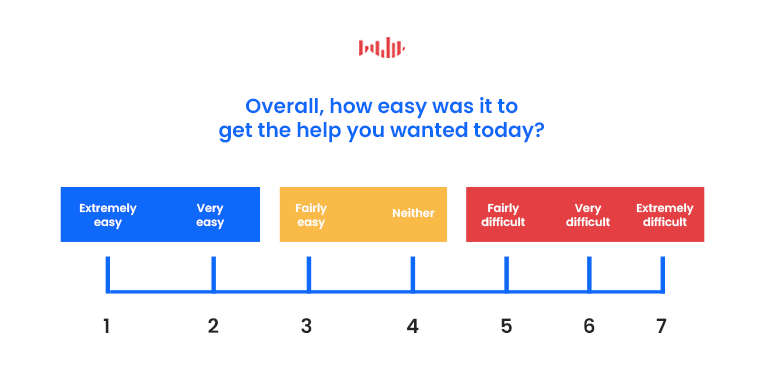
Binary scale questions
Binary scale questions rely on a limit of two answers per question, hence the name “binary.” These can exist simple, yes or no questions, along with questions that can be answered with graphics such as thumbs up/ thumbs down, or with happy face/ sad face emojis.
As such, these questions are used with visual rating surveys. However, they can also function within custom surveys, should there be any obscurity to previous answers in them.
That is because these questions are used to clear any ambiguity surrounding some rating scale questions. For example, the 3-star experience of one responder can be the 5-star experience of another. But were they both satisfied with the experience overall?
An example of a binary scale question: Did you find the product you were looking for on our website? Yes / No
Nominal questions
Nominal questions are naming scales, which pinpoint different categories of questions. These answers cannot be assigned a numerical value. In addition, the answers are not created to be connected in any way, unless you add an option for “all of the above.”
The answers to nominal questions have no specific order; they are meant to carry significance for variable labels only.
An example of a nominal question: Which brand of laptops from our store do you prefer?
Answers: Apple, Microsoft, Dell, Acer, Samsung, Asos
As you can see, the order of these answers doesn’t matter, neither are they tied to any number. The significance lies in the label only; it shows researchers which brand its customers prefer.
These can be used in custom surveys or even in visual ratings surveys, if you use an emoji for each option. This can be done to test branding, with each emoji taking the form of a brand’s logo.
Likert scale questions
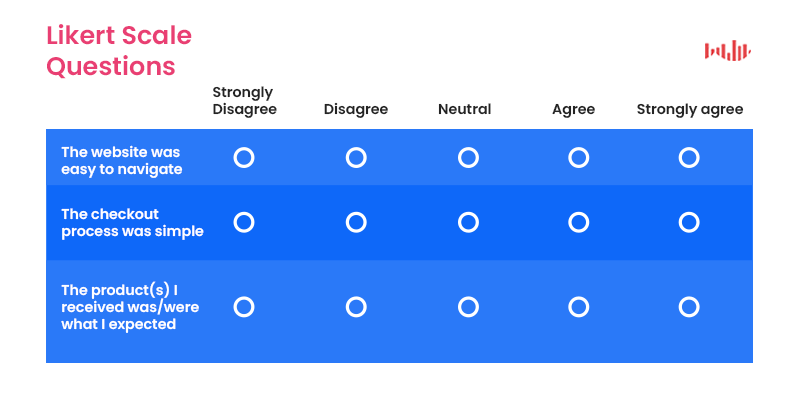
Likert scale questions are used in Likert scale surveys. The answers exist as a 5- or 7- point scale to determine how customers feel. The bottom number (always 1) represents the lowest extreme view, while the top number (either a 5 or 7) represents the highest extreme view.
The numbers 3 (on a 5-point scale) and 4 (on a 7-point scale), represent the middle, aka the moderate view.
An example of a Likert scale question:
On a scale of 1-5, how strongly do you agree with the following:
[Your product]’s had an easy to use and understand our instruction manual.
1 - Strongly disagree
2 - Somewhat disagree
3 - Neither agree nor disagree
4 - Somewhat agree
5 - Strongly agree
Semantic differential questions
Like Likert scale questions, Semantic differential questions also feature a 5- or 7-point scale. These questions, however, offer a differentiator, in that they ask for more descriptive answers.
Instead of asking responders to either agree or disagree to a statement, semantic differential questions ask the customer to select an option that most accurately represents their opinion on a product, service or experience.
An example of a semantic differential question:
How helpful was our interactive website experience?
1 - Not helpful at all
2 - Barely helpful
3 - Neither helpful nor unhelpful
4 - Somewhat helpful
5 - Very helpful
Open-ended questions
An open-ended question can be used to buttress virtually any of the mentioned survey types in this article. That is because these questions use an open field for customers to type out their answers.
Usually, these questions ask for clarity or elaboration on a previous multiple-choice or ratings question. These questions are best used to cut back on any ambiguity or to delve further into an issue without the need to ask multiple questions.
Since the answer is in a field that customers can type, they can express themselves more fully and add all the details present in a problem, concern or preference.
This type of question is more difficult to process since it is longer and unique to each respondent, however, it is excellent for finding new ideas and opportunities for betterment.
An example of an open-ended question:
Is there anything on our website we could improve for a better digital experience? If so, what is it?
More Examples of Specific Questions for Customer Satisfaction
The above was designed so that you can become fully acquainted with the main question types in customer satisfaction surveys.
But with so many questions out there in relation to customer satisfaction, it may be confusing to tie specific ones to a question type, let alone a survey type. Here are a few more examples of specific questions you may potentially use for your customer feedback survey.
- How would you rate the interaction you had with our salesman, on a scale of 1-5?
- Question type: Customer Satisfaction (CSAT)
- Can you rate how likely you are to recommend our brand to a friend or family member on a scale of 0-10?
- Question type: NPS survey question
- How easy was it to solve your issue with us? (Select from 1-5)
- Question type: Customer Effort Score (CES)
- Why did you feel you had an overwhelmingly positive experience? (multiple-choice)
- Question type: Custom question
- How can we improve this product? Please provide all the feedback you can.
- Question type: Open-ended
Excelling in the Customer Satisfaction Front
Customer satisfaction can be a tough nut to crack, even when you build a seemingly perfect customer survey. To put insult to injury, customer satisfaction surveys have low response rates, as they hover between 10-30%.
You should remember that these surveys should only be sent to customers, ie, the portion of your target market that has made purchases.
Also, keep in mind that in some cases, you may combine all survey questions and even all survey types into one survey, so long as it is relevant to your case.
Make sure each survey you create to study customer satisfaction is centered around topics relevant to your customers’ recent purchases and experiences. Apply best practices and you’ll improve the low response rate in no time.
Frequently asked questions
What is a customer survey?
A customer survey is any type of survey that is distributed to existing customers of a business.
What can a customer survey achieve?
Customer surveys help a company understand customer satisfaction and research changes that can be made to improve customer satisfaction.
What types of questions are included in customer surveys?
The types of questions used in customer surveys are multiple-choice questions, rating scale questions, binary scale questions, nominal questions, Likert scale questions, semantic differential questions, and open-ended questions.
What is a Likert scale?
A Likert scale is a type of question used in surveys. It provides a statement and asks respondents to rate their level of agreement or disagreement on a scale of 1 - 5.
How are semantic differential questions different from Likert scale questions?
Semantic differential questions offer more descriptive answers than Likert scale questions, which only allow respondents to agree or disagree with a statement.
How to Conduct Grocery Market Research Like a Pro
How to Conduct Grocery Market Research Like a Pro

Whether you own a grocery chain or a small supermarket, grocery market research is a powerful practice when it comes to understanding your target market, improving your offerings, and investigating this industry at large.
In recent years, the grocery industry has undergone unprecedented change due to the advent of online shopping and the emergence of mega-retailers, like Amazon and Target Business owners who wish to succeed must stay abreast of changes; market research is the most data-driven and accurate way to do so.
This article will teach you how to conduct grocery market research like a pro so you can stay competitive and meet your customers’ evolving needs.
The Purpose of Grocery Market Research
Market research describes the process of collecting, analyzing, and interpreting data in order to better understand a certain market. Grocery market research is a fundamental tool in:
- Identifying and catering to specific customer segments via market segmentation Consumer behaviors during their digital experiences
- Competitive analysis of your sector
- Current trends and growth opportunities
- The success of marketing campaigns and how they can be improved
- The demand for new products, services, and experiences
- Desired distribution methods
- Geographical demand for your services (allowing you to venture into other geographical regions if the demand is high enough)
A successful market research project will help you make better decisions about how to improve or grow your business. There is an inherent risk in starting or making changes to your grocery business, but market research can provide assurance about the changes you need to make.
The Makeup of Grocery Market Research
Market research involves two data types: primary and secondary research. Primary research is highly-specific information that has not yet been collected, and thus has to be collected and analyzed by the business owner. Some examples of primary research are:
- Survey research (online or by mail)
- Focus groups
- Interviews (phone or in-person)
- Observation studies
- User testing (more relevant for online grocers)
Secondary research involves the gathering and analysis of existing, publicly-available data. This includes free and paid-for resources. Secondary sources of information include:
- Market research reports
- Case studies and white papers
- Government statistic sites
- Industry reports
- Research companies
- Search trend sites (Google Trends) and SEO platforms
Once both information sets have been gathered, you will need to spend time organizing and analyzing the data in order to make conclusions that are relevant to your business.
How to Perform Grocery Market Research

Like other types of market research, there is a certain process you can expect to follow while undertaking grocery market research. However, there are some considerations that are unique to the grocery industry. By understanding these unique aspects, you will be better poised to collect the right type of primary and secondary research.
Your general approach to grocery market research should cover the following:
- Identify your target market. Understand who your potential customers are. If you have a brick-and-mortar store, you will need to consider the demographics, needs, preferences, and aversions of those in the surrounding area to understand spending patterns and their unique needs. Online stores will need to take a broader look at consumer behavior to identify their target market. Survey research, including quantitative and qualitative research, can help you identify and scrutinize your target market.
- Understand your target market’s behaviors. The goal is to understand the spending habits and preferences of your prospective customers. By understanding their behaviors and motivations, you can create more targeted and precise marketing campaigns that are relevant to your customers.
- Analyze consumption and saturation. Secondary research, such as the examination of spending statistics and employment statistics, can help you assess how much demand there is for your grocery store and current market saturation. The goal is to identify a niche where the demand is high, but the market is not yet saturated.
- Identify the competition. Understand what your competitors are doing so you can offer a better or varied experience. Consider how their marketing strategies and messaging are succeeding or failing. Use secondary research and visit your competitors’ digital and brick and mortar properties in order to better understand your competition.
- Outline your unique value proposition. Even in a saturated market, you may be able to differentiate yourself to offer a competitive grocery shopping experience. For example, you might offer certain product lines that your local competitors don’t. Or you may offer a free delivery service within a certain radius. If there is plenty of local competition, try to identify at least one way you are different and then plan your marketing strategy around those differentials.
Once you have finished this process, you should have a better idea if your business can meet the needs of your target market. If you have unanswered questions or need to dive deeper into the specifics of your niche market, consider deploying a survey to get clarification.
Secondary Research Sources

We have compiled some of the leading reports about the US grocery industry to help you get started on your grocery market research.
- MarketResearch.com’ Grocers Market Research Reports: This website is an excellent source of market research reports. Search for grocery market research reports at a broad level or for more specific subsectors. Also available are U.S. and worldwide outlook reports, along with country-specific reports.
- IBISWorld’s Supermarkets & Grocery Stores Industry Market Research Report: IBISWorld is a global company offering in-depth market analysis from trusted industry experts. Their supermarket industry report covers key topics including historical and projected growth, revenue forecasts, market size, industry trends, and profitability analysis.
- Online Grocery Market Outlook & Key Findings: This report focuses specifically on the online grocery industry and provides a global perspective on the industry growth. The report includes an analysis of how COVID-19 has shifted consumer behavior and the long-term outlook for this industry.
- U.S. Bureau of Labor Statistics, Food and Beverage Stores: The BLS is a treasure trove of free data about the food and beverage stores industry. Explore employment and earnings figures, workplace trends, prices, and more.
- Progressive Grocer: This grocery industry magazine has been publishing articles and reports for the retail food industry since 1922. It is a trusted source of both news and published research reports.
- Grocery Trade Shows: Trade shows are an excellent way to learn more about the latest trends and growth opportunities. Thanks to COVID, many of these can be accessed right from your living room indefinitely.
Using Survey Research for Grocery Market Research
The grocery market industry has undergone rapid change and growth during the unprecedented era of COVID-19, raising the demand for market research in this industry. Established retailers are scrambling to meet the needs of their customers, while entrepreneurs search for openings in a competitive landscape.
Grocery market research should be an indispensable part of your marketing and planning strategy for the coming year. From providing a clearer picture of how the market has changed to providing insight into your customers’ evolving needs, market research is an invaluable tool that you can use to intelligently guide your efforts.
From traditional to online, grocery store owners must ready themselves for more change. If you are trying to identify ways to remain relevant or seize an opportunity for yourself, now is the time to start your market research.
Frequently asked questions
What is grocery market research?
Grocery market research is the process of gathering and analyzing data in order to better understand the target market and customers of an existing or planned grocery store.
What are good sources of primary information for grocery market research?
When it comes to grocery market research, good sources of primary information include surveys, focus groups, observational studies, interviews, and user testing.
What are good sources of secondary information for grocery market research?
Market research reports, industry reports, case studies, statistics sites, and search trend sites are all good sources of secondary information for grocery market research.
What is a grocery store’s target market?
A target market is the group of customers that has the potential to purchase goods from a business. For grocery market research, this is typically limited to a geographical region around the supermarket, but it may extend further if the grocery has delivery services.
How can grocery market research help improve marketing campaigns?
By better understanding the target market and the demand for a grocery store’s products, a company can plan marketing campaigns that will reach the right audience and speak to their needs.
Diving Into the Customer Satisfaction Survey
Diving Into the Customer Satisfaction Survey
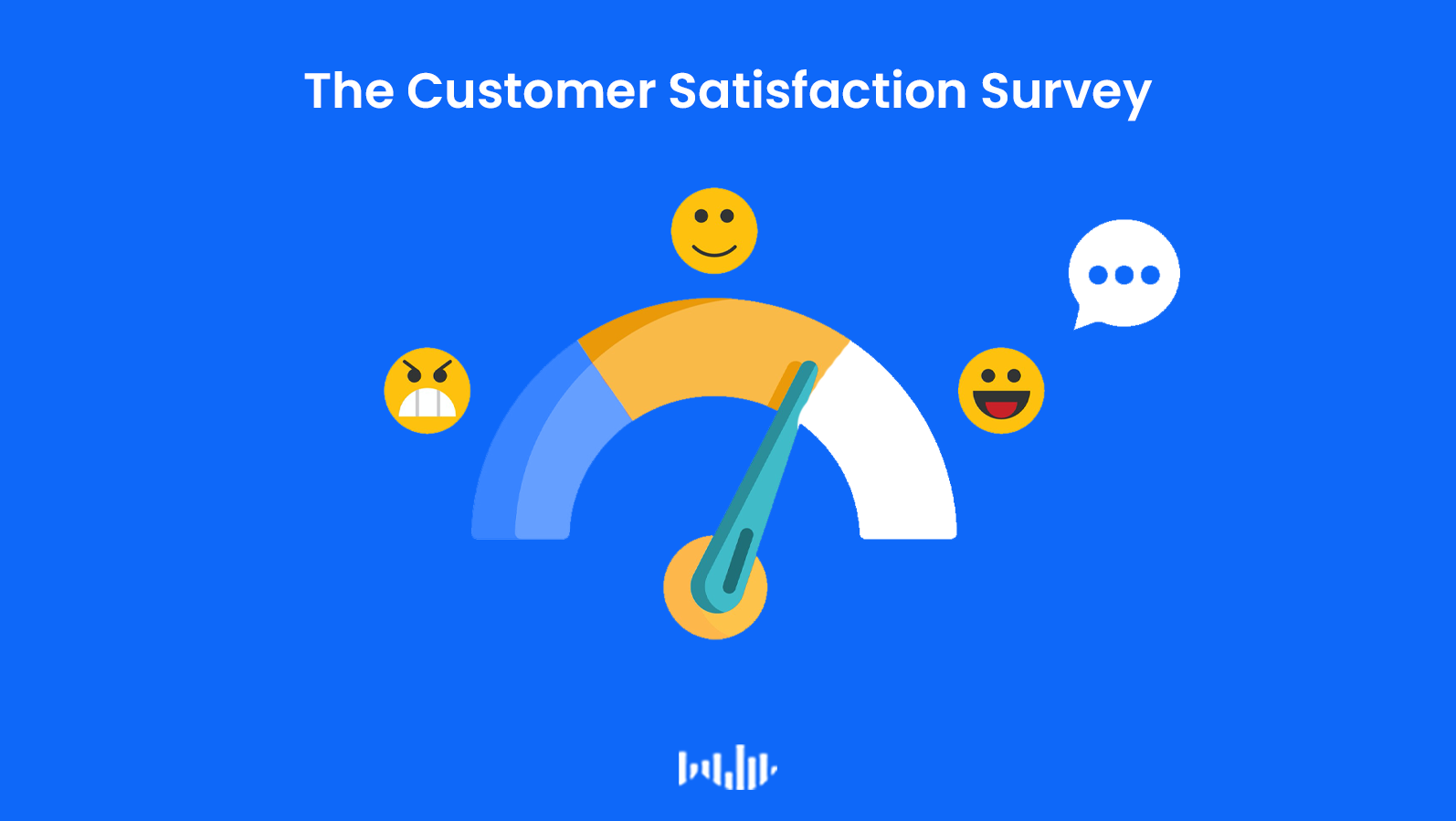
Customer satisfaction. This lofty achievement is often, if not always, the main objective for businesses small and large.
It goes without saying that this concept is attributed to revenue, continued purchases, customer loyalty and brand awareness (via reviews and mentions by happy customers).
So how can your business accomplish customer satisfaction? By putting the customer satisfaction survey into practice.
This survey is specifically tailored to gauge customer satisfaction within your niche, and most importantly, within your company. This article will explore this survey type and how you can optimize it for all your business needs, including market research, marketing and more.
Defining Customer Satisfaction
This term appears to be self-evident, but for business purposes, it is best to understand it precisely before you venture out on any efforts to perfect it — or if you’re a startup — to reach it.
Customer satisfaction denotes the measurement that ascertains the degree to which customers are satisfied with a company’s products, services and experiences. In short, it reveals whether your customers are happy with your offering and by how much.
Your business can determine its own levels of customer satisfaction with the customer satisfaction survey.
The Customer Satisfaction Survey & its Applications
As its name implies, a customer satisfaction survey is a survey developed for businesses to understand what their customers think about their products, services and company at large.
As such, this kind of survey can cover all the bases of customer satisfaction, such as user experience, mobile experience, customer support and all the other facets of doing business/ interacting with your company.
The customer satisfaction survey can take the form of a questionnaire, or a ratings-based survey (think numerical values, stars and other icons used to express good or poor satisfaction).
This kind of survey can be used in a number of different campaigns, based on their macro applications. These include:
These applications may seem too broad to be used for uncovering customer satisfaction alone — and they are. These macro applications serve as the starting points of survey research, which in turn can be used to buttress them. The same applies to a customer satisfaction survey, which can be used in relation to these campaigns.
For example, you can test how satisfied customers are with a product, as it relates to an advertising campaign around it.
Or, perhaps you need to test your customer support satisfaction for branding. You may conduct a survey that asks about specific wording your representatives may have used.
There are several ways to form a customer satisfaction survey.
5 Types of Customer Satisfaction Surveys
You can design these surveys in a number of ways, but there are five main types of formats that these surveys take. Each survey type provides a different kind of angle into customer satisfaction. As such, they should be used at different points in the customer journey.
Net Promoter Score Surveys (NPS)
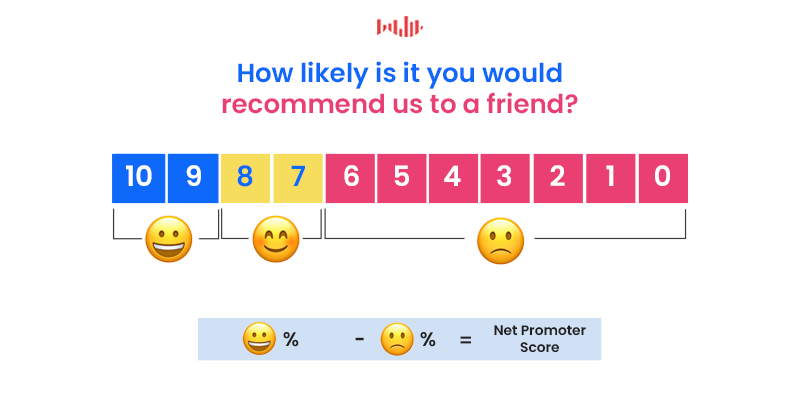
Conceived in 2003 by Fred Reichheld, of Bain & Company, the Net Promoter Score (NPS) survey has become prominent across industries. This score-based survey asks customers to rate the likelihood of their recommending your business, on a scale of 0-10.
The respondents who ranked their likelihood between 0-6 are known as the detractors, those who are generally unhappy with your product, service or experience.
Those who respond in the 7-8 range are called passives, as they are not impressed with your company, but aren’t dissatisfied either. They are situated in the middle of this score, despite their numbers going slightly past the mid-section.
Respondents in the 9-10 range are the most ideal, as they represent the promoters of your business; they are on the higher end of satisfaction.
To calculate your NPS, subtract the percent of detractors away from the percent of promoters. For example, if 60% of responses were Promoters and 15% were Detractors, your Net Promoter Score would be 45. (The NPS is expressed as a digit, not a percentage.
Pro tip: Always add a follow-up open-ended question, so that your customers can explain why they selected their rating.
Customer Satisfaction Score (CSAT)
The CSAT represents a customer’s fulfillment in a particular situation. This is where you can apply this survey to a wide range of applications. For example, you can assess customer happiness during an interaction with a salesperson or with a product feature.
The Customer Satisfaction Score is made up of two parts: a numerically-based question and an open-ended question. The numerically-based question is a scale representing satisfaction.
The CSAT can ask, for example, to rate satisfaction with an experience from a scale of 1 (very dissatisfied to 5 (very satisfied).
To calculate the CSAT, use the following formula: The total number of satisfied responses / total number of responses) x 100. Round the result to the nearest whole number.
Respondents who answer this with either 4 or 5 are considered to be satisfied customers.
Pro tip: Use the CSAT to understand your customer sentiment at a specific point in time. This includes after a product demo, after a technical support call, after visiting a service center or store.
Customer Effort Score (CES)
This type of survey measures the amount of effort that was required for a customer to take part in an action. This survey focuses solely on the process of achieving an end result. Also called the effort, measuring the process determines how easy or difficult the flow is in your product/service.
As such, even if the result may be enjoyable to the customer, the process itself may not be.
This service is important, as brands today must provide quality experiences; the product or service alone is not enough. To fully satisfy customers, brands must make it smooth and easy to complete any process, whether it’s signing up for a subscription or ordering a product.
To calculate the CES, use a 5-point scale to gauge the ease of the customers’ actions. For example, it is common to ask: “how easy was it to find this product on our site?” The options should range from “very difficult,” to “somewhat difficult,” to “somewhat easy” and so on.
The answers on the “disagree” side of the spectrum would be number 1 and 2. 3 would be neutral, while 4 and 5 would be on the “agree” side. The CES is centered around the “agree” answers.
As such, to find the CES add all the “agree” answers (either 4 or 5), then divide them by the total number of respondents.
For example, if 100 customers replied with a 4 or 5, but there are 200 of them who took the survey, 50% of them are in the “agree” range. That means your CES score is 50. Brands ought to aim for high CES scores, as it points to customers happy in achieving an intended outcome.
Visual Rating Surveys
Also called emoji surveys, visual rating surveys allow customers to respond with graphic, rather than with a number. All the choices they can select are composed of a graphic and there are various ones you can use.
Each answer shows a different amount of each graphic to express the level of satisfaction. For example, a question on how satisfied customers are with a service can range from 1 to 5 stars or other emojis.
Here are a few examples of the types of visual rating surveys:
- Star surveys
- Heart surveys
- Thumbs up/down surveys
- Smiley surveys
These kinds of surveys are visually appealing, easy to complete and take little to no time to finish.
Custom Surveys
Best used to understand how and why customer satisfaction was exceeded, met or failed to reach expectations, these surveys are often used as follow-ups to previous surveys.
Custom surveys include questions that delve further into customer satisfaction to discover specifics that other surveys could not make readily available.
To piggyback on previous surveys or previous responses, you can ask follow-up questions by way of advanced skip logic. This will automatically direct your respondents to different question paths, depending on the answers they provided.
You should organize your custom survey feedback into three segments: fix now, fix later and fine as is. This will allow you to see which issues and experiences are the most pressing and which can be amended later.
6 Types of Questions to Use in a Customer Satisfaction Survey
The types of questions you use will largely depend on the kind of survey type you implement into your customer satisfaction campaign.
However, since they all fall under the same research campaign and measure virtually the same thing, there is going to be a lot of overlap between the questions you use for each survey type.
The following lays out the 6 question types to use for measuring customer satisfaction.
- Multiple-choice questions: limit the number of answers a respondent can use. Little effort is required to answer (as opposed to open-ended questions).
- They can include rating scale questions, binary scale questions, nominal questions, Likert scale questions, and semantic differential questions.
- Rating scale questions: use multiple-choice questions that correspond to a scale, such as the CSAT, for customer support, or the probability of product recommendation (NPS)
- These are also called ordinal questions.
- Binary scale questions: Allow for only two answers, such as yes or no, or a thumbs up or down.
- These are used to cut back on obscure results.

An example of a binary scale question
- These are used to cut back on obscure results.
- Nominal questions: Use different categories of answers with no numbers attached.
- Likert scale questions: Questions on a 5-7-point scale to assess customer sentiment.
- 1 represents the lowest end of the view (strongly disagree) while 7 is at the highest end of the opinion (strongly agree)
- Semantic differential questions: Uses a 5-7-point scale, but goes beyond agreeing and disagreeing.
Using this Survey to Lure in New Customers
Unlike other surveys, which are used to scrutinize your target market, identify it or segment it further, the customer satisfaction survey deals solely with customers, ie, the segment that has already bought from you.
Not everyone in your target market is a customer, as this group denotes the people most likely to buy from you — not the people who already made a purchase.
Customers are every bit as important to study as prospects, as they help you discover what your company exceeds at and where there’s room for improvement. Measuring customer satisfaction will inform your business on how to better prepare your service, experiences and offerings for everyone in your target market.
As such, you’ll know how to better lure in new customers and upkeep their satisfaction. But most importantly, a customer satisfaction survey helps bridge the gap between one-time purchasers and loyal customers. Retaining your customers is key to keeping your business afloat, as they represent a continuous stream of revenue and revenue opportunities.
Frequently asked questions
What is a customer satisfaction survey?
A customer satisfaction survey is a type of survey that is designed to measure how happy or satisfied existing customers are with a product or service.
What is a Net Promoter Score survey?
A Net Promoter Score (NPS) survey is a short survey that is used to measure the likelihood that someone will recommend a product, service, or company to someone else. The survey is a good way of gauging overall customer satisfaction.
What is a CSAT?
A CSAT, or Customer Satisfaction Score, is a short survey that measures how satisfied a customer was with a specific situation. It consists of a numerical-based question and an open-ended response.
What is a Customer Effort Score?
A Customer Effort Score (CES) is a survey that measures the amount of effort required to complete a certain action. The survey consists of a single question with a 5-point scale response.
What is a binary scale question?
A binary scale question is a type of survey question that has only two possible responses (e.g. yes or no).
The Complete Survey Response Rate Guide
The Complete Survey Response Rate Guide

In a survey, the survey response rate is a unit used to measure the accuracy of the data that you collected, making it an important factor to consider when interpreting survey results. After taking the time to plan and create a survey, a low response rate can be very disappointing.
Even worse, a low response rate may result in the incorrect interpretation of survey data, leading to a major misstep in business planning.
When planning and creating a survey, you should aim to maximize the survey response rate by paying attention to factors that may hinder respondents from starting or completing your survey.
This guide will help you understand why the survey response rate matters and what you can do to improve the response rate of the surveys you create.
Understanding the survey response rate
Also referred to as the completion rate, return rate, or simply the response rate, this unit is crucial to survey research. The survey response rate and its affiliated monikers are used to indicate the percentage of people who completed a survey compared to the total sample size (people who received the survey).
For example, if you sent out 1,000 surveys and received 150 completed surveys, your response rate would be 15%. When looking at the response rate for a survey you conducted, you will need to assess whether the response rate is poor, average, or good.
There is not a standard “good” survey response rate because it varies greatly based on several components, such as the industry, survey type, and the method of distribution (e.g. phone, in-person, email, live site or app).
Why the survey response rate matters
Calculating the survey response rate is straightforward, but interpreting its effect on survey data is more nuanced. As such, it is vital that you carefully consider this metric when analyzing survey data.
A low response rate usually increases the likelihood of sampling bias. Sampling bias is the term used when the results of a survey do not return random results. The lower your response rate, the more likely it is that you will experience sampling bias.
An example of potential sampling bias due to a low response rate:
Let’s say that a company wants to know what incentives are most appealing to their employees. They decide to focus on softer incentives like free lunches, happy hours, and other team-building activities. They send the survey out to 200 employees and receive 32 responses, giving them a 16% response rate.
When examining the data, the HR team noted that 94% of these respondents expressed great satisfaction with the team-building incentives. With such a positive response, the team could be tempted to assume that these incentives are a valuable asset to current and prospective employees.
Fortunately, knowing that the survey had a low response rate that could result in sampling bias, the team decides to look closer at the results before drawing conclusions.
While reviewing the data, the HR team sees that most respondents were in the 22 – 28 age group, leaving them with new questions. Were younger people more likely to respond because they like these activities and want them to continue? Does this age group have more interest in voicing their opinions?
With more questions than answers, the HR team decides to revisit their survey and try to improve the response rate before making changes to their incentive program.
5 ways to improve your survey response rate
Here is the most important part of this guide. Since the response rate is an indication of survey quality and can improve the accuracy of results, you should do everything you can to promote a higher response rate.
Here are our top tips for creating a survey to improve your response rate:
#1: Understand and state the purpose of your survey
Before you create screening criteria or questions, think deeply about the purpose of your survey. What do you hope to learn by conducting this survey? What are the top questions you want to answer for your business? Revisit your purpose before, during, and after your survey development to ensure you stay on target.
For even better results, share some of this information with your respondents. Instead of asking someone to “answer a few questions,” you may get a better response when your respondents understand why they are being asked to participate.
#2: Design your survey well
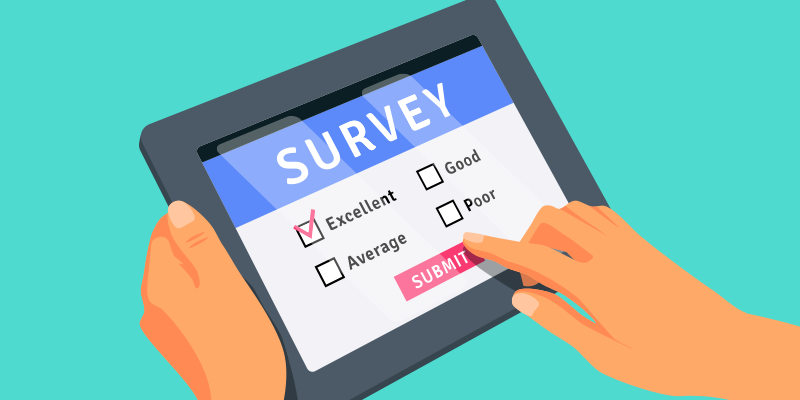
A well-designed survey offers a better user experience (UX) for respondents and increases the likelihood that they will complete the survey. Survey design covers both the physical aspect of the survey as well as the questions within the survey.
Some best practices for survey design include:
- Create a visually appealing survey. Questions should be laid out nicely and responses should be easy to select. Include images if necessary.
- Make sure the language of the survey appeals to your target audience. Use language that is clear and appropriate for the audience. The questions should be easy to understand with responses that make sense within the contact of the question.
- Since many people will complete an online survey on a mobile device, verify that the survey works as well on phones and tablets as it does on a computer.
- Personalize your survey to your target market. Further audience segmentation will help organize your user base.
- Add advanced skip logic so that respondents are routed only to relevant questions based on their answers.
- Use a variety of question types. Varying your question types between multiple-choice, rating, and open-ended can help increase your survey response rate.
#3: Keep it short
Long surveys are less likely to be completed, making survey length one of the primary factors in survey response rate. Ideally, you will keep your survey short and focused – a survey that takes longer than 5 minutes to complete will not perform as well as one that takes 3 minutes.
Of equal importance, let your respondents know how long it will take them to complete the survey – and make sure your estimate is accurate or you may notice that respondents start the survey and do not finish it.
#4: Reach the right audience

In order to increase the number of people who complete your survey, you need to reach them and offer them a survey that they can complete on their own terms. A professional survey platform can help you reach a bigger, more relevant audience, thereby increasing the odds you will find the right people to complete your survey.
With a larger number of prospects, it is also important to carefully consider your screening questions to filter out those who are not in your target market, area of study or are less likely to complete the survey. A good survey platform will make it easy for you to screen users before they begin taking your survey.
#5: Choose the right incentive
While some people truly enjoy filling out a survey, the vast majority of respondents are reluctant to spend valuable time answering a survey without some type of incentive. There is no “one size fits all incentive” – the type of incentive you offer must be attractive to your specific survey group.
B2B customers are more likely to be motivated by intrinsic incentives, such as eventually receiving the results of your research or understanding that their response will help you improve their experience.
Other survey audiences are better motivated by extrinsic rewards, such as discounts and coupons. If you have an online shop, offering a 10% discount on a subsequent purchase can help dramatically improve your survey response rate.
An appealing introduction:
In our scenario above, the HR team could encourage responses from a wider demographic if someone explains the importance of the survey during a company-wide meeting and again when distributing the survey.
Here is an example of an introduction that could improve the survey’s response rate:
“Hi Sam. We know that incentives are a powerful tool to retain employees and attract the best talent to join our team. We want to understand if the incentives we currently offer are appealing to all of our employees.
The survey will only take 3 minutes to complete. Your responses will help us update our incentive program to ensure that our incentives are relevant to all of our employees.”
Improve your survey rate, improve your market research
In many cases, using a survey platform will make it easier to maximize your survey response rate. For example, the platform should make it easy to add an attractive visual design that works well on any device.
It should also come with a call-out (a button or banner that prompts users to take the survey). Additionally, the platform should give you advanced tools to select your desired target audience by way of demographics options.
Another important benefit of a professional survey platform is that you can understand your survey’s response rate in real time, allowing you to respond quickly to correct a survey with a low response rate. The ability to course correct can save you time, money, and provide higher accuracy of results, so you can be confident about making business changes based on the outcome of your survey.
Frequently asked questions
What is the survey response rate?
The survey response rate is a term used to describe the percentage of people who completed a survey compared to the total number of people who received the survey.
Why is the survey response rate important?
It is important to understand the survey response rate to ensure that your conclusions are not a result of sampling bias. Sampling bias can occur when the response rate is low.
How does length affect the survey response rate?
Respondents are less likely to complete longer surveys, which can result in a lower response rate.
How does targeting the right audience improve response rate?
When you target the appropriate audience for your survey, the questions are more likely to be interesting and engaging for that audience. An engaged audience is more likely to complete a survey, thus improving the response rate.
How can the mobile survey experience improve the response rate?
When a survey is well-designed for a mobile device, respondents will be able to complete the survey at any time and place, and from any device. You can expect a higher response rate when you allow respondents to complete the survey when it suits them best.













